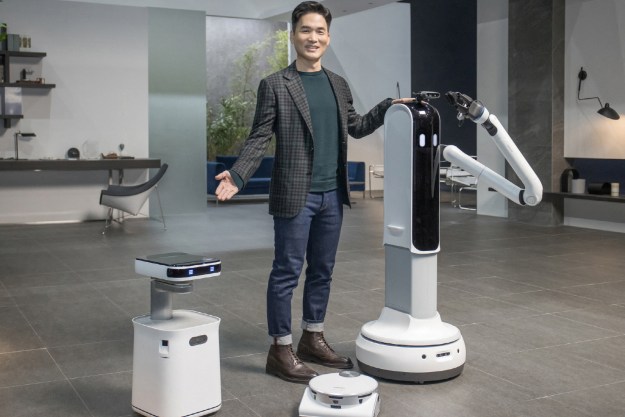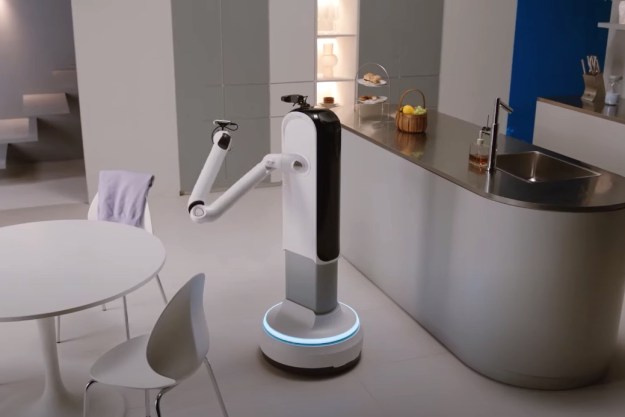It’s the early hours of the morning. An explosion at a chemical plant, caused when multiple containers caught fire, has triggered a blaze that’s now raging out of control. Worse, the plant is located in the middle of a densely wooded area, causing a small patch of trees to start burning. Visibility is poor. It’s a bad situation with the potential to get a whole lot worse in a hurry.
Better send in the robots.
At least, that’s the scenario painted in a new video demonstration by Estonian company Milrem Robotics. Since 2013, the company has been working to build robots to tackle some of the world’s toughest and most challenging environments, whether that’s in defense, agriculture, forestry, rescue services, or mining. This month, in combination with InnoVfoam, a maker of specialist foam extinguishing technology, it introduced its latest vertical: Firefighting robots.
Enter the robot firefighters
“The Multiscope Rescue is based on the know-how and experience we gained when developing our first UGV, the THeMIS,” Kuldar Väärsi, CEO of Milrem Robotics, told Digital Trends. Themis, by the way, is the ancient Greek goddess of fairness and custom, equipped with Scales of Justice for dishing out law and order.
THeMIS, meanwhile, is a UGV — an unmanned ground vehicle — developed by Milrem for military use. It is, in essence, a robot tank designed to be deployed as a remote weapon station, and detection and disposal unit for improvised explosive devices (IEDs). Used by the Estonian army and other forces around the world, it boasts a modular design, hybrid diesel-electric drive system, and impressive ability to heft payloads of up to 750 kilos or 1,650 pounds.

“The THeMIS was tested during various military exercises in harsh environments and climates,” Väärsi said. “Everything learned during developing the THeMIS has been incorporated into the Multiscope.”
The Multiscope Rescue is the name of Milrem’s new, improved firefighting robot. Built along the lines of THeMIS, but offering a host of new and improved abilities, it has a maximum payload capacity of 1,200 kilos (2,654 pounds) and a pull force of 21,000 N — which is sufficient to carry a whole lot of hoses and other equipment. It’s also modular, and can be kitted out with a variety of payloads — including a tethered drone to act as an “eye in the sky” to gain added information.
Assisting human firefighters
In Milrem’s video demo, a fleet of these tracked robots spring into action as the fire alarm is sounded. Transporting heavy duty hoses to the scene of the blaze, they head straight into the inferno. The drone, deployed from the back of one of the robots, hovers above; communicating everything that it sees using its complement of on-board sensors. Not a single human needs to get close to the fire.
“Firefighting is an extremely hazardous profession,” Dennis Liefhebber, sales manager at InnoVfoam, told Digital Trends. “As [with] many other sectors, fire and rescue is struggling to find enough manpower to cover their areas of responsibility. Utilizing robots can help [us] perform the needed tasks with less manpower, less energy, and in a shorter time frame. We say that robots can be used in the most hazardous situations where it is too dangerous for firefighters to enter.”
Milrem Robotics and InnoVfoam don’t just believe that firefighting robots will protect the lives of firefighters, however. They may, in some cases, make it possible for more extreme fire situations (think large buildings, oil and gas blazes, and forest fires) to be brought back under control more speedily.

“Firefighters can use our firefighting robots in most firefighting situations since firefighting is a time and energy consuming activity,” Kuldar Väärsi said. “The robots can reach fires much more quickly than humans, and are able to perform the needed tasks such as laying out fire hoses over long distances much [faster and] without getting tired.”
The robot firefighters can be remotely controlled. Alternatively, they can be set to follow other vehicles, or even to operate autonomously using image recognition for obstacle detection and avoidance. Once they’re at the scene of a fire, on-board cameras can identify the critical risk areas and line up a clear trajectory to deploy the hoses. These hoses then proceed to dispense water and foam at volumes of up to 20,000 liters per minute.
Coming soon to a blaze near you?
Milrem Robotics’ robot firefighters aren’t the only example of tech for helping fight fires. Other projects Digital Trends has covered range from AR headsets to help firefighters to better see and communicate in a blaze to more humanoid robots that could accompany them into a burning building. If these technologies can work as promised, they could prove to be a game-changer for the way fires are fought today; as big a revolution as bomb-disposal robots have been in years past.
“The Multiscope Rescue has [already] been deployed to various landscape fires,” Väärsi said. “One mission was in a military firing range with a lot of explosive ordnance lying around that had not exploded. The firefighters sent the Multiscope to put out the fire. These missions were done with payloads the firefighters had available and supplied.”
Additional testing of InnoVfoam’s foam-spewing technology is planned for sometime this May or June. After that, provided all goes according to plan, hopefully it won’t be long before it’s rolled out to work on the front lines.
Editors' Recommendations
- Check out Wing’s largest delivery drone yet
- It’s drone delivery, but not as we know it
- Tiny insect-inspired robot has speed of a cockroach and agility of a cheetah
- Dreame Technology is the next robot vacuum maker you should know about
- Google is planning to test drones for fighting fires



